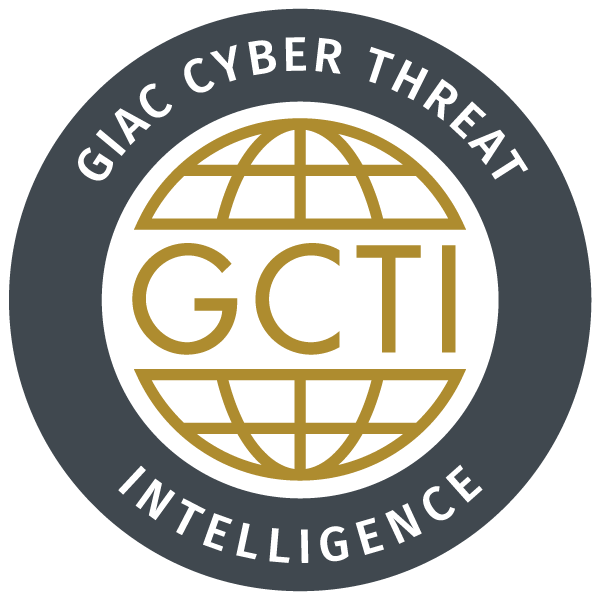Areas Covered
- Strategic, operational, and tactical cyber threat intelligence application & fundamentals
- Open source intelligence and campaigns
- Intelligence applications and intrusion analysis
- Analysis of intelligence, attribution, collecting and storing data sets
- Kill chain, diamond model, and courses of action matrix
- Malware as a collection source, pivoting, and sharing intelligence
Who is GCTI for?
- Incident response team members
- Threat hunters
- Security operations center personnel
- Information security practitioners
- Experienced digital forensic analysts
- Federal agents and law enforcement officials
GCTI with CyberLive
GIAC knows that cyber security professionals need:
- Discipline-specific certifications
- Practical testing that validates their knowledge and hands-on skills
In response to this industry-wide need, GIAC developed CyberLive - hands-on, real-world practical testing.
CyberLive testing creates a lab environment where cyber practitioners prove their knowledge, understanding, and skill using:
- Actual programs
- Actual code
- Virtual machines
Candidates are asked practical questions that require performance of real-world-like tasks that mimic specialized job roles.
Exam Format
- 1 proctored exam
- 75-82 questions
- 2-3 hours
- Minimum passing score of 71%
Delivery
NOTE: All GIAC Certification exams are web-based and required to be proctored. There are two proctoring options: remote proctoring through ProctorU, and onsite proctoring through PearsonVUE. Click here for more information.
GIAC certification attempts will be activated in your GIAC account after your application has been approved and according to the terms of your purchase. Details on delivery will be provided along with your registration confirmation upon payment. You will receive an email notification when your certification attempt has been activated in your account. You will have 120 days from the date of activation to complete your certification attempt.
Exam Certification Objectives & Outcome Statements
- Analysis of Intelligence The candidate will demonstrate an understanding of the techniques employed in analyzing information. The candidate will also demonstrate an understanding obstacles to accurate analysis, such as fallacies and bias, and how to recognize and avoid them.
- Campaigns and Attribution The candidate will demonstrate an understanding of identifying and profiling intrusion characteristics and external intelligence into campaigns. The candidate will demonstrate an understanding of the importance of attribution and the factors that are considered when making an attribution.
- Collecting and Storing Data Sets The candidate will demonstrate an understanding of collecting and storing data from collection sources such as threat feeds, domains, TLS certificates, and internal sources.
- Intelligence Application The candidate will demonstrate an understanding of the practical application of gathering, analyzing, and using intelligence. Additionally, the candidate will demonstrate an understanding of how well-known cyber attacks can inform cyber intelligence professionals today.
- Intelligence Fundamentals The candidate will demonstrate an understanding of fundamental cyber threat intelligence definitions and concepts. The candidate will also demonstrate a basic working knowledge of technologies that provide intelligence analysts with data, such as network indicators, log repositories, and forensics tools.
- Kill Chain, Diamond Model, and Courses of Action Matrix The candidate will demonstrate an understanding of the Kill Chain, Diamond Model, and Courses of Actions Matrix and how they are used together to analyze intrusions.
- Malware as a Collection Source The candidate will demonstrate an understanding of malware analysis tools and techniques to derive intelligence.
- Pivoting The candidate will demonstrate an understanding of pivoting to expand intelligence, pivot analysis, the ability to use link analysis tools, and ability perform domain analysis to expand intelligence collections.
- Sharing Intelligence The candidate will demonstrate an understanding of methods and practices of storing intelligence from various sources. The candidate will demonstrate an understanding of the processes, tools, and techniques used in sharing intelligence. The candidate will demonstrate an understanding of effectively sharing tactical intelligence with executives by writing accurate and effective reports and using such capabilities as assessments.
Other Resources
- Training is available in a variety of modalities including live training and OnDemand
- Practical work experience can help ensure that you have mastered the skills necessary for certification
- College level courses or self paced study through another program or materials may meet the needs for mastery.
- Get information about the procedure to contest exam results.
Practice Tests
- These tests are a simulation of the real exam allowing you to become familiar with the test engine and style of questions.
- Practice exams are a gauge to determine if your preparation methods are sufficient.
- The practice bank questions are limited so you may encounter the same question on practice tests when multiple practice tests are purchased.
- Practice exams never include actual exam questions.
- Purchase a GCTI practice test here.
- GIAC recommends leveraging additional study methods for test preparation.





